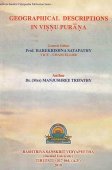Puranasamhita, Purāṇasaṃhitā: 5 definitions
Introduction:
Puranasamhita means something in Hinduism, Sanskrit. If you want to know the exact meaning, history, etymology or English translation of this term then check out the descriptions on this page. Add your comment or reference to a book if you want to contribute to this summary article.
In Hinduism
Purana and Itihasa (epic history)
Source: Cologne Digital Sanskrit Dictionaries: The Purana Index1a) Purāṇasaṃhitā (पुराणसंहिता).—A reference to the Matsyapurāṇa; superior to all the Śāstras; a road to Dharma, Artha and Kāma;1 the last chapter is an appendix dealing with rules as to how the Purāṇa must be worshipped, read or heard. If they disregard the rules they would not only not get the fruits there of, but will be born as dogs, pigs, crows, etc. The vācaka must be honoured as Vyāsa and Aṅgiras;2 consists of ākhyāna, upākhyāna, gathas and kalpaja (br. p.) (Kulakarmas, Vāyu-purāṇa);3 Reference to Parāśara and Viṣṇu Purāṇa;4 follows Vedic tradition.5
- 1) Matsya-purāṇa 290. 20, 25, 291. 1, 36.
- 2) Ib. Ch. 292 (whole).
- 3) Brahmāṇḍa-purāṇa II. 34. 21; Vāyu-purāṇa 60. 21. Viṣṇu-purāṇa III. 6. 16-17.
- 4) Ib. I. 1. 26; VI. 8. 2-3.
- 5) Ib. VI. 8. 12.
1b) Personified: came up to see Trivikrama Hari.*
- * Bhāgavata-purāṇa VIII. 21. 2.
Purāṇasamhita (पुराणसम्हित) refers to the “composition of Puranic lore”.—The Puranic tradition of the human origin of Purāṇas is based on seeing Vyāsa not as the editor of divine Purāṇa but as the arranger of already existing material. As it is said: “He (Vyāsa) who understands the true meaning of Puranic lore, composed the Purāṇasamhita out of tales, episodes, ballads and description of the ages” (cf. Brahmāṇḍapurāṇa II.32.21, Varāhapurāṇa 1.60.21 and Viṣṇupurāṇa 6.15).
We are told that Vyāsa taught this Purāṇasamhita to his disciple Sūta Lomaharṣaṇa or Romaharṣaṇa, who in turn taught it in six version to six of his disciples. Three of these composed their own Saṃhitās; these three together with Lomaharṣaṇa’s comprise the basic compilation, Mūlasaṃhitā from which the later eighteen Purāṇas were derived.

The Purana (पुराण, purāṇas) refers to Sanskrit literature preserving ancient India’s vast cultural history, including historical legends, religious ceremonies, various arts and sciences. The eighteen mahapuranas total over 400,000 shlokas (metrical couplets) and date to at least several centuries BCE.
Languages of India and abroad
Sanskrit dictionary
Source: Cologne Digital Sanskrit Dictionaries: Cappeller Sanskrit-English DictionaryPurāṇasaṃhitā (पुराणसंहिता).—[feminine] collection of the Purāṇas.
Source: Cologne Digital Sanskrit Dictionaries: Monier-Williams Sanskrit-English DictionaryPurāṇasaṃhitā (पुराणसंहिता):—[=purāṇa-saṃhitā] [from purāṇa > pur] f. a collection of the P°, [Bhāgavata-purāṇa]
[Sanskrit to German]
Sanskrit, also spelled संस्कृतम् (saṃskṛtam), is an ancient language of India commonly seen as the grandmother of the Indo-European language family (even English!). Closely allied with Prakrit and Pali, Sanskrit is more exhaustive in both grammar and terms and has the most extensive collection of literature in the world, greatly surpassing its sister-languages Greek and Latin.
See also (Relevant definitions)
Partial matches: Purana, Samhita, Puraana.
Full-text: Vaktar, Satyavrata.
Relevant text
Search found 15 books and stories containing Puranasamhita, Purana-samhita, Purāṇa-saṃhitā, Purāṇasaṃhitā; (plurals include: Puranasamhitas, samhitas, saṃhitās, Purāṇasaṃhitās). You can also click to the full overview containing English textual excerpts. Below are direct links for the most relevant articles:
The Markandeya Purana (Study) (by Chandamita Bhattacharya)
1.6: Number of Purāṇa < [Chapter 1]
1.4: Date of the Purāṇas < [Chapter 1]
1.3: Characteristics of Purāṇa < [Chapter 1]
The Skanda Purana (by G. V. Tagare)
Chapter 1 - Queries of Sages < [Section 1 - Prabhāsa-kṣetra-māhātmya]
Chapter 1 - Purāṇa Texts Described < [Section 3 - Revā-khaṇḍa]
Chapter 30 - Celebratory visit of Godāvarī < [Section 4 - Dvārakā-māhātmya]
Puranic encyclopaedia (by Vettam Mani)
The Puranas < [Third Section]
The Linga Purana (by J. L. Shastri)
Introduction (1): The Liṅga-purāṇa
Chapter 64 - Grant of boons by Pulastya < [Section 1 - Uttarabhāga]
Related products

